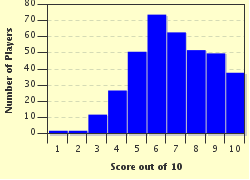Quiz Answer Key and Fun Facts
1. What is a pussywillow?
2. What is a dwarf pug?
3. Do you know what a bloomery is?
4. What is an eggplant?
5. Oyez! Oyez! I dips me lid to ye if you can tell me surrebutter is?
6. Now give it to me straight. What is a barleycorn?
7. Do you know what foxgloves are?
8. Apart from the obvious, who or what is a dead donkey?
9. What is an oldsquaw?
10. Bringing up the rear of the field, what is a road apple?
Source: Author
Creedy
This quiz was reviewed by FunTrivia editor
LadyCaitriona before going online.
Any errors found in FunTrivia content are routinely corrected through our feedback system.


